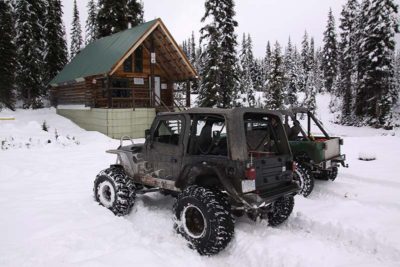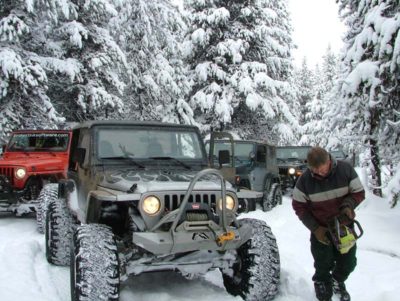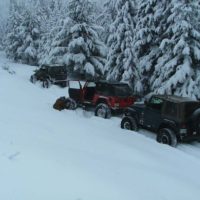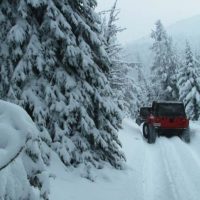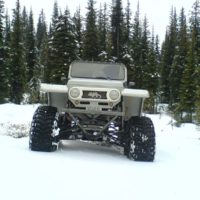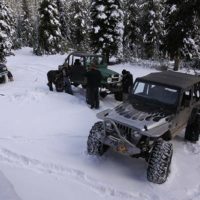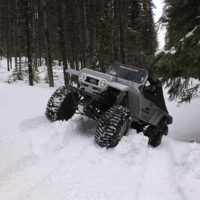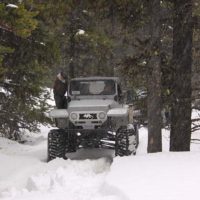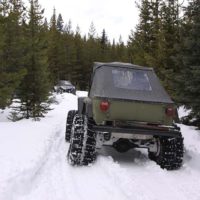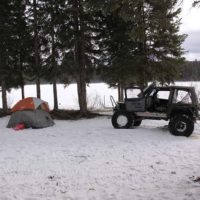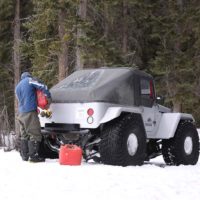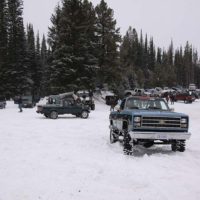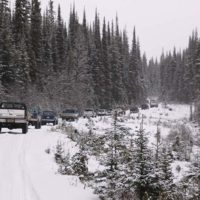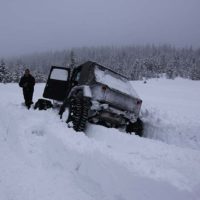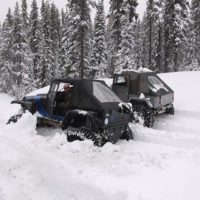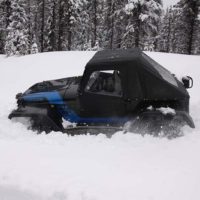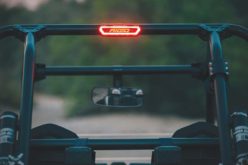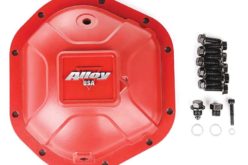Snow Wheelin’: What you need to know before going off-roading during the Winter

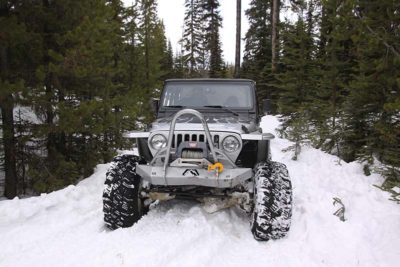
For many, winter is that dreaded time on our roads. Highway closures, snow and ice make for challenging driving conditions, but for some crazy few, they peer at the sky waiting for that white stuff to come drifting down. I’m not talking about skiers or snowmobilers, but some crazy guys with giant balloon tires on their trucks, Jeeps and Land Cruisers, and massively huge engines to power the big tires, and many more who have embraced winter and still get their 4x4s out for fun in the white stuff.
We have to embrace winter in Canada, and many friends to the south are embracing it, too, swapping out their summer 4×4 trail tires for fatter, larger rubber they can deflate to single digit PSI to float on the ever deepening white stuff.
I’ve had a wide range of 4x4s over the years, from dedicated trail rigs to all-out big-tire snow machines, and it’s winter that gets me going still to get out on the big tires and go four-wheeling in the snow. Winter can take a mild-mannered forest services road and turn it into a giant playground, when the snow reaches 1-2-3 or even 4-feet deep for those with the big tires. I hear drivers who can’t stand getting out in the white stuff; they end up getting stuck, digging holes and generally making it nowhere. There is a technique that, once you master it, makes snow play a real blast even on regular trail tires. Embrace winter, get out, have fun; it’s not the time of year to put away your Jeep till spring – the fun season has just begun!
Tricks for snow (note: ice is a different beast) –
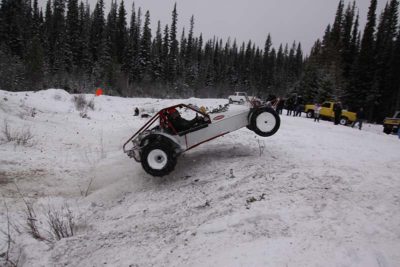
Spinning your tires generally does nothing. I’ve drilled this into the heads of many wheelers when it comes to snow; they generally get it after many a furled brow looking at me saying how? It’s throttle control and managing your power and rolling on the gas not stabbing it, and keeping momentum when you need it, and knowing when to stop, and learning how to rock in your holes once you dig them to get back on top and moving again. Once it clicks in, it changes everything. Spinning makes ice, ice is pain. Spinning also digs holes, and holes are a pain, too. Avoid spinning your tires!
Tire pressure.
Here is where I find wheels that bolt your tires onto them, aka beadlock wheels, really earn their keep. The lower the tire pressure, the fatter your tire gets on the bottom. The fatter your tire gets on the bottom, the more displacement you have. The more displacement you have, all the better to stay on top of the snow – and not spin to make ice and dig holes. You don’t have to have beadlock wheels, you can get pretty low on a conventional wheel – you just need to be more careful.
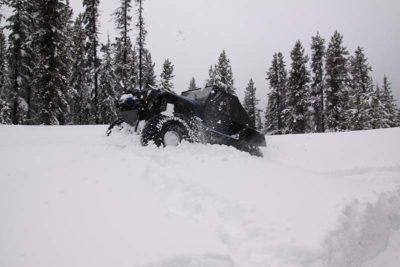
Okay, yes, air is all around us; I’m talking the compressed kind that fills tires. Also take some time in your garage and learn how to get a tire on your rims if one falls off. When you’re very low in tire pressure, tires do fall off rims – even on rims with beadlocks on the outside. Buy a good air compressor and learn how to manage your tires. Flat tires work better in the snow – period. Flat tires don’t make ice and don’t dig holes.
Tires – get big ones, and groove them up.
Here is one of those areas where bigger is better. Remember we are not talking ice here – we are talking snow. You can’t get far when you’re trying to push 2-3 feet of snow with your headlights – you have to get on top. I had a Jeep with a 46-inch-tall tire, and the tires were 2 feet wide. The Jeep weighed 5,800 lbs… big trucks weigh lots. I did an interesting test once. I measured my snow boots’ ground area and my weight (I’ll keep that to myself), I weighed my snowmobile and measured my track area, I weighed my Jeep, and dropped the tire pressure to 2 PSI which was my snow wheeling tire pressure, and measured those. It was very interesting.
In my boots I was 2.2 lbs per square inch, but I have to pick a foot up to move. That doubles to 4.4 psi. My sled was 1.6 psi. My Jeep on 2 psi in the tires was 2.4 psi – but it didn’t have to pick a tire up to move… that’s how you stay on top of the snow. And stop the spinning and stop digging holes.
Most are pretty hesitant to take a brand new set of tires and groove them to pieces. I have dedicated snow-wheeling tires – I groove everything. Currently, they are 44 inches tall and 2 feet wide. It takes a lot of modifications to get tires this big on anything. Getting the fattest, largest tires you can onto your rig and not rubbing them round on rocky trails (square edges are your friend), then getting at them and cutting extra grooves into them to bite into the snow will make you 1,000 percent more successful in the white stuff. Oh, and not spinning and not digging holes…
Argue with me all you like, there are people I just can’t convince. Tire chains are for ice, not for snow. Tire chains are designed to dig through stuff to find traction. Chains dig holes in the snow – see #1 and you don’t need chains. Sometimes though, depending where you live, ice on trails to get to the snow is a fact of life, and it sucks. Move to somewhere with no ice… or get chains and stay out of the deep snow. I have no other answer for you.
Dress for success!
It’s winter. No one likes a whiner – buy good snow boots, wear long johns, pack extra clothes, boot liners, a couple of pairs of gloves, etc… Its way more fun if you’re not freezing to death. I camped for a week in -20C snow. Had a great time – we built a big fire for the evenings, I had a down sleeping bag…and no, don’t sleep on an air mattress, it’s -20 out – how cold do you think the air is in your air mattress? The snow is warmer! Bring a foam roll, and extra pillowcases. We are 90 percent water, and you will freeze your pillow by breathing on it all night once your warm head is off it. Oh, and at -20, beer freezes (bury it in the snow to keep it, ahem… warmer) or drink Scotch. Scotch solves everything – and toques.
Learn how to get your buddies unstuck (and yourself).
You’re having fun in the snow, you forgot #1 and dug holes you can’t get out of. You’re in a snow field and nowhere close to a tree to winch to. Now what? Remember, no one likes a whiner. Buy and learn how to properly use a tug strap. Keep it handy – you’re going to use it lots. A tug strap is not a tow strap. Tug straps stretch and retain energy – and use that energy to bounce you out of holes. Rarely, if ever, when out with the big boys of snow wheelers do we winch. Actually, most don’t even have a winch, as it adds weight in the wrong spot. However, all know how to A: tug someone out, and B: how to react when someone is tugging you out. Oh, and bring stuff to dig with; there will be times you will need to dig yourself out. Also, your tug strap seconds as a base for your jack – bundle it up in a pile, place jack on pile, and it’s just like your flat tires, the larger area disperses weight allowing you to jack on an otherwise un-jackable surface. Oh, and a ratchet strap to ratchet your axle to the frame so you don’t have to jack so high if you need to fix a tire on our flexible trail rigs, which leads into…
You should do this any time you go off-road. I off-road a lot on my own – but rarely in the snow. Tools, jackets, food, drinks, tire repair kit, recovery gear, air compressor, fuel (you will go through 2X the amount of fuel in the snow that you think you will). Let people know where you’re going, be prepared to stay the night, and stay warm.
A note on ice.
I like to break ice out of the snow-wheeling category. Ice is something we tend to deal with on our winter roads or busy Forest Service roads, where lots of people are driving and spinning. When a lot of cars are driving, snowplows are working. This compacts the snow, and ice is a different animal. Big fat tires increase your footprint and reduce your weight per square inch. I’ve slid backwards down an icy road on my big tires where a pickup on proper winter ice tires looked at me like I was an idiot. I had the wrong tires… I moved over into the snowy ditch and stayed off the ice and crawled right up. Make sure you have the right tires for the job. Ice and snow are far more about the right tires than how big and bad and flexible your 4×4 is. Oh, and not spinning, which makes more ice – and sometimes holes…




